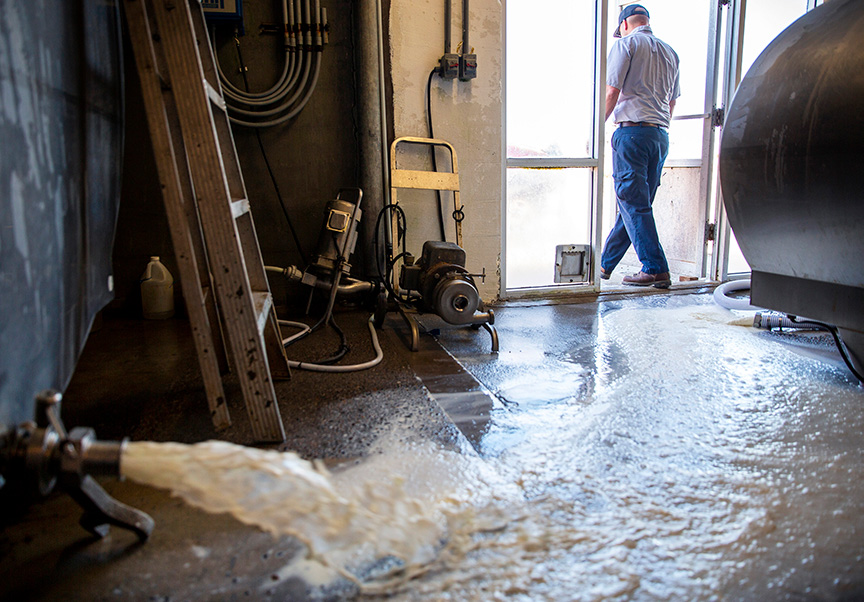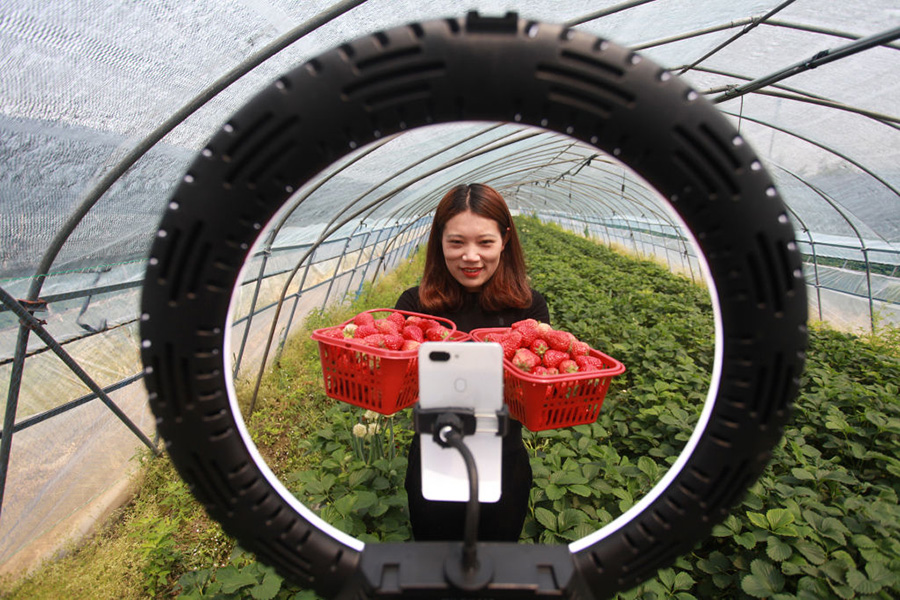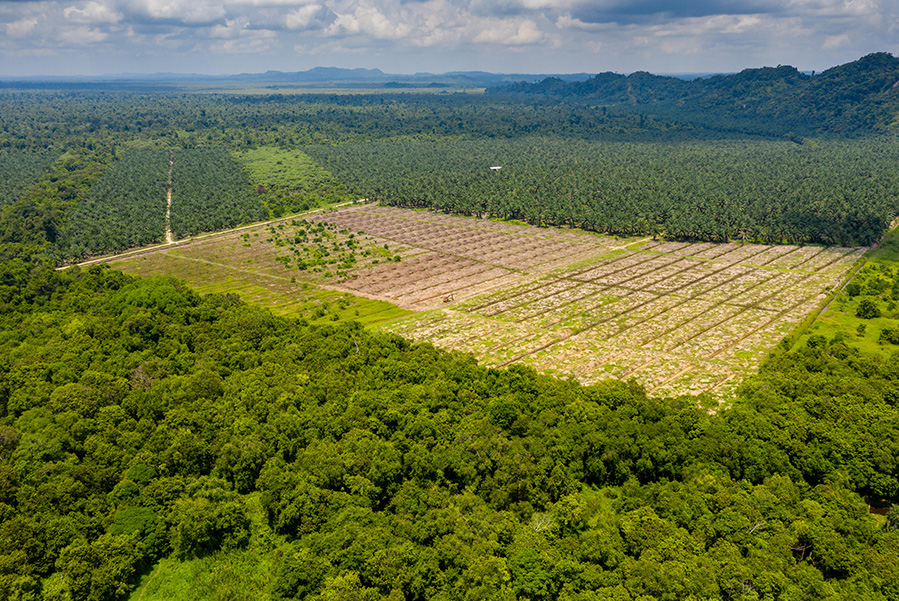Most of us won’t soon forget that disconcerting moment last spring when grocery store shelves were suddenly bare where the flour, pasta and other staples should have been. The news told of farmers dumping milk — nearly 4 million gallons a day, by one account — smashing eggs and euthanizing chickens that they couldn’t get to market. Crops worth billions of dollars were wasted, some rotting in the field, as restaurants and other food service businesses, shuttered by lockdowns, stopped buying.
The problem was short-lived, fortunately, as growers pivoted to new buyers, shippers and packers adapted, exports resumed and the food system — the complex web of players that move food from farm to fork — came back to life. “Overall, the food system has been quite resilient,” says Johan Swinnen, director general of the International Food Policy Research Institute, a leading international think tank. “It’s hard to imagine a bigger shock than we’ve had now. And despite that, if you look at the rich countries, even countries like China, the food supply has not been a problem almost anywhere.”
The food system didn’t break, but it did flinch — and the public noticed. “People experienced for the first time that you can’t take for granted that whenever you need something, it’s there on the market shelf,” says Matin Qaim, an agricultural economist at the University of Göttingen in Germany.
For Qaim and other experts, the experience with Covid-19 can be viewed as a kind of stress test for our global food system, highlighting its strengths as well as its weak points. It’s helping them focus on what needs to change to build a truly resilient system. And we’re likely to need that resilience soon, they warn, as climate change makes droughts, floods, windstorms and other extreme events more common. Those challenges, they say, will require changes in where and how we grow food, and in the way society structures the supply chains that keep food, fertilizer and other commodities moving around the world.

When restaurants closed during the spring 2020 pandemic lockdowns, many food suppliers lost some of their biggest clients, leaving them with no buyers for their products. This Idaho dairy farmer ended up dumping 4,100 gallons of unsold milk down the drain.
CREDIT: PAT SUTPHIN / TIMES-NEWS VIA AP
The next crisis could well be worse. After all, global harvests have been mostly unaffected by Covid-19, and food prices didn’t rise dramatically in 2020 (though they have been edging up in early 2021). When lockdowns shuttered restaurants, school cafeterias and workplace eateries — the food service industry that formerly accounted for about half the food consumed — suppliers pivoted within a few weeks, finding ways to repackage their products into smaller portions for retail sale.
But we may not be so lucky next time. “It’s not unlikely that sometime over the next decade or two we will have a significantly worse drought,” says Tim Benton, a food systems researcher at Chatham House, a UK-based think tank. Such a drought or some other equally severe weather event, or a major crop disease outbreak, could decrease global food production by 10 or 15 percent, he says, leading to skyrocketing food prices, hunger and widespread panic. “That is orders of magnitude worse than Covid.”
Global food prices (here measured by the UN Food and Agriculture Organization’s food price index) fluctuate depending on global supply and demand. When drought reduced global harvests in 2008 and 2011–12, food prices spiked sharply upward. In contrast, Covid-19 led to only a small increase in food prices in 2020 and the first months of 2021.
Risky trade-off
Our modern food system emphasizes efficiency over resilience — and that comes at a cost. Vast monocultures of Russian wheat, American corn and Brazilian soybeans feed a worldwide market, but the lack of genetic diversity leaves crops vulnerable to disease. Meat-packing plants have grown larger, allowing economies of scale — but when Covid-19 hit two beef-packing plants in Alberta last spring, the resulting closures reduced Canadian beef-processing capacity by an estimated 40 percent.
And at every link in the food supply chain, growers and processors have become used to dealing with single buyers or sellers, thus avoiding the extra expense of catering to multiple needs. Many vegetable growers, for example, sell only to the food service industry, allowing them to focus their packing lines on the large quantities that commercial buyers seek.
“We have stripped out redundancy in the name of efficiency to drive down prices,” says Benton. “We have stripped out diversity. We expect to be able to buy goods whatever the season. And, as Covid has illustrated, we have lost the flexibility in our supply chains. If you lose your buyer, you end up throwing things away.”
This is already changing, as food producers, processors and shippers struggle to cope with Covid-19. In Thailand and Malaysia, for example, small-scale farmers and fishers have taken advantage of ubiquitous mobile phones to sell their products directly to local consumers online, finding new markets as their usual wholesalers have stopped buying. And already, at least one large food-processing firm that once bought its raw material from a single supplier told Swinnen it is now sourcing more widely. “It’s diversifying your supply system — and diversification is always good in terms of risk management,” he says.

When the Covid-19 lockdown shuttered many conventional markets, some farmers quickly adapted by selling their crops directly to consumers online.
CREDIT: PHOTO BY MENG DELONG / VCG VIA GETTY IMAGES
Such efforts have been hindered so far, because growers and processors typically don’t assign a monetary value to flexibility, says Timothy Richards, an agricultural economist at Arizona State University. Richards is working on ways to remedy that. His initial calculations, for example, compare the long-run profitability of a hypothetical American onion farmer who sells only to the food service industry to an otherwise identical farmer who sells to both food service and retail supermarkets. The latter farmer must spend more to maintain two separate packing operations — one for, say, 50-pound bags for industry and another for 3-pound bags for retail sale. However, the added flexibility may make that farmer more viable in the long run, though Richards does not have precise numbers yet. “There is value in developing that resilience,” he says.
Resilience will be even more important as the effects of climate change bring not just hotter growing seasons but also more extreme droughts and storms. To cope, farmers will need to consider measures such as changing their crop mix to favor less water-intensive crops, Richards says.
Any efforts to make food systems more resilient must also deal with the massive role of international trade in food products. American consumers eat Peruvian asparagus and Australian lamb while Chinese eat American pork and Brazilian soybeans, in a global carousel of food trade that tops $1 trillion annually. In essence, many countries are outsourcing the production of their foods to places better able to grow them cheaply.
This has helped keep food prices low, but at some risk. “You’re essentially betting on the stability of the world to provide your food,” says Benton. If we can’t count on that stability — in a future threatened by climate change and the political turmoil it might cause, say — that bet starts to look like a bad idea.
Instead, policymakers could focus on building a food system that provides healthy diets in a sustainable, resilient way. Such a system might involve a greater diversity of production and shorter, more regional supply chains. “You might end up with a completely different-feeling food system,” Benton says.
Not everyone agrees with this prescription, however. “I would find that not only wrong, but dangerous,” says Qaim. “Most countries in the world wouldn’t be able to provide healthy and balanced diets locally, year-round.” Moreover, he points out, smaller-scale food networks are more vulnerable to local or regional droughts, floods and storms. Instead of localizing food supplies, governments should aim to diversify supply chains at every level. “Resilience will always mean having diverse sources of food, regional but also international,” he concludes.
Global food trade is huge, with the US importing and exporting tens of billions of dollars’ worth of food products every year. This map shows flows between the US and major trading regions in 2018. (Regions with less than $1 billion in trade are not shown.)
Strengthening infrastructure
Some of the most useful reforms for building more robust food systems are less controversial, and certainly less glamorous. In many poorer countries, simply building better roads and markets may make the biggest difference to local food systems.
Even during the pandemic, food moved to consumers remarkably well, considering what poorer countries were working with, says Thomas Reardon, an agricultural economist at Michigan State University who spent decades working in Africa, Asia and Latin America. “The people in the supply chains were heroes. They were doing incredible work. What needs fixing is the physical infrastructure and policies. Policies that triple-tax them as they cross borders. Wholesale markets that were built in the ’70s and hadn’t been repaired. Lack of electricity.”
When Reardon worked in Burkina Faso, for example, his top priority was culverts to keep roads from washing out in storms. “It sounds absurd,” he says, “but that’s where we were.” Such improvements could go a long way toward keeping food shipments moving at times of crisis.
That’s not the only lesson the current pandemic holds for the global food system, however. After all, the virus that causes Covid-19 most likely emerged from interactions between wild animals and people. Such interactions tend to be most common at the agricultural frontier, where native forests are being cleared for farmland. And SARS-CoV-2 is far from the only germ to make the leap from forest to city, says Chris Barrett, an agricultural economist at Cornell University.
Indeed, when Barrett and his colleagues dug through the scientific literature on emerging diseases and agriculture, they found that agriculture — including its expansion into former forest — was at least partly responsible for at least half of all infectious diseases that have jumped from animals to humans since the 1940s. That proportion is likely to increase still further if the agricultural frontier continues to expand, so halting the encroachment of agricultural land into the wild is an important part of preventing the next pandemic, Barrett says.

Many human pathogens originate in wild animals living near the boundary between farm and forest. To minimize the chance of future pandemics, experts say, society should avoid further expansion of agricultural land into native forest, such as this clearing of Malaysian rainforest for palm oil plantations.
CREDIT: RDW AERIAL IMAGING / ALAMY STOCK PHOTO
Already, governments are starting to pay attention to the need to do things differently at the agricultural frontier. “We’re starting to see those connections made,” says Jamie Morrison, the director of the Food Systems and Food Safety Division of the UN’s Food and Agriculture Organization. “That has been a positive, I think, coming out of the last year.”
If adding more farmland is off the table, then farmers will need to get more food from the existing land base. “Even more than before, we need yield-increasing technologies,” says Qaim. Organic farming, which generally avoids synthetic chemical inputs, and which many educated Westerners see as the best way forward, offers lower yields on average, so it is unlikely to meet the need on its own, Qaim and his colleague Eva-Marie Meemken argue in the 2018 Annual Review of Resource Economics.
Better farming practices, especially more targeted use of fertilizers and pesticides, may be able to achieve peak yields with fewer chemicals, easing some of the pressure to expand farmland. But other measures will also be necessary. If people eat less meat and dairy, they will reduce the need for farmland to grow animal feed, which now accounts for 33 percent of global cropland. Minimizing food waste — currently nearly another third of global food production — would also ease the pressure. But genetic modification should also be on the table, says David Zilberman, an agricultural economist at the University of California, Berkeley, because it offers the fastest, most targeted way to add new traits to crop plants and farm animals that can help them adapt to changing conditions.
Momentum for change
Many agricultural experts have been calling for reforms since long before the pandemic, of course. But their push is now gaining momentum because of what may be Covid-19’s most important effect on the world’s food system: an impetus for reform, both in government policies and in business practices. “I think the biggest opportunity is in people’s minds,” says Swinnen. “Even if the food was still on the table, there was a threat that it may not be so.”
That has accelerated several trends that were already underway in the food sector (see “Food tech trends” below). The FAO’s Morrison also sees a growing willingness by national governments to discuss food system transformation in the run-up to the UN Food Systems Summit in September 2021, where member nations will try to explore ways to make the global food system more equitable and sustainable.
“People are increasingly aware that we need to be better prepared next time, and that preparation requires investment,” says Barrett. “We shouldn’t waste a crisis. Ten years from now, we will look back and see that the pandemic had a horrific impact in the short term, but it may have accelerated us toward a more humane system than we otherwise would have had.”
Watch the replay of “Baking Resilience into the Food System,” an online event held on March 24, 2021. Additional resources available here.
Covid-19 has highlighted one more food-related problem today, perhaps the biggest of all — though it falls outside the food supply chain proper. Last year’s lockdowns left hundreds of millions of people suddenly unemployed or underemployed and without cash to buy the food that was still in the market. Cue the long lines at food pantries. (Feeding America, the largest anti-hunger association in the US, reported a nearly 60 percent increase in food bank users during the pandemic.) “The takeaway is how fragile many people’s access to a healthy diet is,” says Barrett. “They’re just a couple of paychecks away from hoping people will give them a box of free food. And that’s kinda scary.”
Things could have been much worse, if not for rapidly expanding social safety nets that helped replace lost income so that poor people — who bore a disproportionate share of the economic costs of lockdowns — could still eat. By May of 2020, the World Bank reported that 190 countries around the world had upgraded social safety nets or planned to do so, largely by cash transfers to people in need. “There’s really a very significant growth in social security programs around the world,” says Swinnen. “And that’s great.”
But it hasn’t been enough. Globally, the UN estimated in July 2020 that more than 130 million additional people could go hungry as a result of the pandemic, largely because of income losses or disruption of markets, which would be an increase of nearly 20 percent. For children, even a short period of poor nutrition can lead to stunted growth and consequences that last a lifetime. One recent study, not yet peer-reviewed, estimates that Covid-19 is likely to lead to an additional 2.6 million stunted children and 168,000 additional child deaths, largely in South Asia and sub-Saharan Africa.
Whether the next food crisis comes from another pandemic, drought or disease, one of the big lessons from the current pandemic is that to keep people from going hungry, governments will not only need to ensure that food supplies continue when times are bad. They also must ensure that poor people have enough money to buy that food. “If there’s a single take-home message, it’s the importance of safety nets,” says Barrett.
Even the current pandemic could have more hunger in store, since many households have depleted their financial reserves coping with the crisis so far. If another wave of Covid-19 leads to new lockdowns, things could get even worse, says Benton. “It’s not over yet.”
This article is part of Reset: The Science of Crisis & Recovery, an ongoing Knowable Magazine series exploring how the world is navigating the coronavirus pandemic, its consequences and the way forward. Reset is supported by a grant from the Alfred P. Sloan Foundation.




